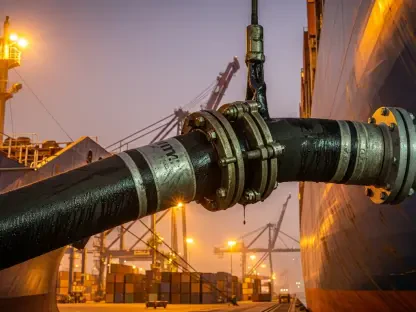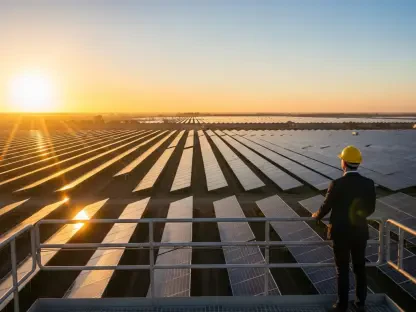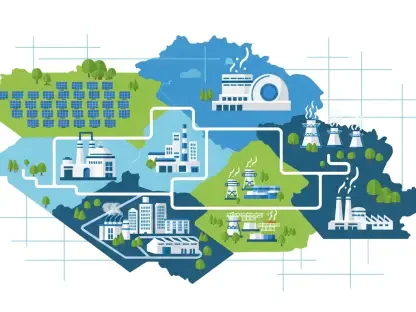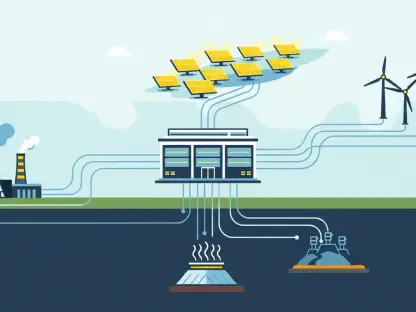Environmental regulations are becoming increasingly strict, leaving vessel owners and operators with uncertainties about which fuel sources to adopt. The current trend towards achieving zero-emission green fuels by 2050, as mandated by the International Maritime Organization (IMO), compels the shipping industry to continually improve vessel efficiency and mitigate emissions. In this context, the concept of using ‘bridge fuels’ like LNG (liquefied natural gas) and bio-LNG emerges as a smart interim measure. These bridge fuels present an opportunity to start transitioning away from more polluting fossil fuels, while the production and availability of zero-emission alternatives are still in development.
Understanding Fossil LNG and Bio-LNG
What is Fossil LNG?
Fossil LNG is derived from natural gas found in underground reserves, both onshore and offshore. It undergoes a process that involves the separation from oil, removal of water, sulfur, and carbon dioxide, and the separation of natural gas liquids. The resultant substance is cooled to form a clear, odorless liquid, typically 85-95% methane, with small amounts of other hydrocarbons and trace gases such as nitrogen and carbon dioxide. This process ensures the gas is purified and safe for usage, resulting in a clean energy source that can be easily stored and transported.
Fossil LNG plays a crucial role in the energy sector because of its relatively lower greenhouse gas emissions compared to other fossil fuels. Additionally, the infrastructure for LNG production and distribution is mature, with numerous facilities worldwide refining and liquefying natural gas. However, while fossil LNG offers a cleaner alternative to traditional marine fuels like heavy fuel oil (HFO), it is still a finite resource that will eventually need to be replaced by renewable energy sources. This necessity underpins the transition towards fuels like bio-LNG, which promise even lower emissions and a reduced environmental impact.
The Emergence of Bio-LNG
Bio-LNG, also known as liquefied biomethane (LBM), boasts lower greenhouse gas emissions compared to fossil LNG. Bio-LNG is produced from the liquefaction of biomethane, which in turn comes from the degradation of biomass and waste via chemical or thermal processes. Sources can include agricultural waste, food waste, sewage sludge, and manure. This makes bio-LNG a renewable fuel, significantly reducing a ship’s carbon footprint when using LNG fuel systems. By utilizing waste products, bio-LNG not only taps into a sustainable resource but also helps in waste management and reduction.
Moreover, the production of bio-LNG can be scaled up as more efficient technologies and processes are developed. A growing interest in renewable energy sources has spurred investments and innovation in the production of bio-LNG, making it an increasingly viable alternative to fossil LNG. This shift is critical for the maritime industry as it works towards meeting stringent environmental regulations while ensuring the economic feasibility of fuel transitions. Bio-LNG stands out as a promising intermediary step, bridging the gap between current fossil fuel use and future zero-emission technologies.
Benefits of Fossil LNG as a Bridge Fuel
Reduced Emissions
Adopting fossil LNG helps to take initial steps towards reducing reliance on more polluting fossil fuels like heavy fuel oil (HFO), particularly in terms of environmental impact, cost-effectiveness, and regulatory compliance. LNG produces substantially lower levels of sulfur oxides (SOx) and nitrogen oxides (NOx) compared to conventional marine fuels such as HFO, assisting in compliance with current IMO regulations. It also decreases particulate matter (PM) emissions, which enhances air quality and aids compliance with regional emissions standards. Additionally, LNG burns cleaner than traditional marine fuels, potentially reducing CO2 emissions by up to 20% and thereby improving a vessel’s Carbon Intensity Indicator (CII) rating.
This reduction in emissions is not just a regulatory benefit but also an operational advantage, as cleaner-burning fuels contribute to a healthier working environment on board ships and in port cities. Crew members and dock workers benefit from reduced exposure to harmful pollutants, while shipping companies can leverage these environmental credentials to enhance their market position and stakeholder relations. The use of fossil LNG thus sets the groundwork for a more sustainable shipping industry, encouraging the adoption of cleaner technologies and practices.
Flexibility and Fuel Availability
LNG engines are highly fuel-efficient, and vessels equipped with dual-fuel engines can switch between LNG and conventional fuels based on fuel availability and price, providing operational flexibility. The global infrastructure for LNG is rapidly expanding, with increasing numbers of ports worldwide providing LNG bunkering stations. This makes it progressively feasible for ships to fuel with LNG along key global shipping routes. Having access to a widespread fueling network ensures that LNG-powered ships can operate with confidence, knowing that refueling options are readily available.
Such flexibility also translates into cost savings, as operators can optimize fuel costs by choosing the most economical option available. This adaptability is particularly valuable in a volatile energy market where fuel prices can fluctuate significantly. By investing in dual-fuel engines and leveraging existing LNG infrastructure, shipping companies can navigate these fluctuations more adeptly, ensuring operational continuity and financial stability. This strategic advantage positions LNG as a critical component in the transition towards more sustainable maritime practices.
Advantages of Bio-LNG as a Bridge Fuel
Substantial Reduction in Carbon Emissions
Bio-LNG is seen as an effective transition fuel because it can significantly reduce carbon emissions while fully zero-emission fuels are still under development and their production is being scaled up. As nearly carbon-neutral, bio-LNG recycles carbon already part of the natural carbon cycle, unlike fossil fuels that emit ancient carbon into the atmosphere. Bio-LNG can potentially reduce emissions by up to 80% compared to conventional marine fuels like HFO. This significant reduction makes bio-LNG a compelling option for those looking to minimize their environmental impact without waiting for the complete shift to zero-emission technologies.
Furthermore, the adoption of bio-LNG aids in achieving intermediate targets set by international regulations while longer-term solutions are perfected. The ability to reduce greenhouse gas emissions so dramatically enhances a vessel’s compliance with evolving environmental standards and underscores the industry’s commitment to sustainability. This proactive approach not only meets current expectations but also prepares the maritime sector for future regulations, fostering a more robust and eco-friendly shipping industry.
Fewer Impurities and Compatibility with Existing Infrastructure
Bio-LNG typically has fewer impurities than fossil LNG because it originates from organic waste that has been previously consumed or processed. This results in lower emissions of harmful by-products upon combustion, such as particulate matter, and also a lower sulfur content. Vessels equipped with LNG-capable engines can use bio-LNG as fuel, leveraging the existing LNG bunkering infrastructure. This compatibility allows for a seamless transition from fossil LNG to bio-LNG without any retrofits, saving both time and money. The ease of switching fuels without significant modifications reduces downtime and operational disruptions, promoting a smoother transition to greener alternatives.
Moreover, leveraging current infrastructure means that the maritime industry can make substantial environmental gains without waiting for extensive new developments. As bio-LNG can be used in existing LNG fuel systems, shipping companies can start reducing their carbon footprints immediately. This practical and efficient approach to fuel transition aligns well with both economic and environmental goals, making bio-LNG a pragmatic choice for advancing towards net-zero emissions. Additionally, it underscores the importance of maintaining and expanding LNG infrastructure, which will continue to be relevant as bio-LNG and other renewable fuels become more prevalent.
Future-Proofing
Vessels using bio-LNG can be more easily converted to run on future carbon-free fuels like green ammonia or green hydrogen when these become available at scale. This readiness ensures that bio-LNG is an attractive fuel for cutting emissions promptly. Starting with LNG and bio-LNG today prepares vessels for 100% carbon-neutral fuels when they become available on a large scale. Transitioning to bio-LNG now lays a solid foundation for the forthcoming evolution of maritime fuel technology, making future upgrades more straightforward and cost-effective.
This approach ensures that investments made today will remain relevant and valuable as new fuels and technologies emerge. By committing to bio-LNG, shipping companies demonstrate foresight and adaptability, positioning themselves to swiftly and smoothly integrate future advancements. This strategic planning aligns with broader sustainability goals and assures stakeholders of the industry’s dedication to minimizing its environmental impact. The capacity to future-proof vessels against forthcoming changes in fuel technology underscores the prudent and forward-thinking nature of adopting bio-LNG as a bridge fuel.
Technical Feasibility of Converting to Alternative Fuels
Modular Design and Structural Commonalities
Converting LNG-capable dual-fuel Wärtsilä engines to run on alternative fuels is relatively straightforward due to their modular design and structural commonalities. Upgrading an engine to other fuels is cost-effective because of the modular, multi-fuel platform these engines offer. Proper planning and budgeting are essential since replacing fuel handling and storage systems can be more expensive than converting an engine. The modular nature of these engines simplifies the process and reduces associated downtime, allowing for more efficient and less costly transitions to alternative fuels.
This modularity also supports a step-by-step approach to transitioning, where parts can be upgraded as needed rather than all at once. This gradual upgrade path minimizes the financial impact and logistical challenges of fuel conversion projects, making them more accessible for shipping companies of various sizes. As the industry moves towards zero-emission fuels, having modular, flexible engines ensures that vessels remain competitive and compliant with emerging regulations, facilitating smoother transitions to greener operations.
Challenges and Solutions
One challenge is that alternative fuels generally have lower volumetric efficiency than diesel or LNG, necessitating larger fuel tanks. These larger tanks require more space, potentially reducing cargo capacity. This trade-off between fuel storage and cargo space is a significant consideration in the planning and implementation of fuel transitions. Properly designed fuel systems and strategic vessel modifications can help mitigate the impact on cargo space and ensure that the vessel’s operational capabilities are maintained.
Additionally, technological advancements and innovations are needed to improve the energy density and storage solutions for alternative fuels. Collaborating with expert partners can aid in optimizing space and weight onboard, maximizing the benefits of an alternative fuel conversion. By addressing these challenges proactively, the maritime industry can ensure that the transition to cleaner fuels is both practical and efficient, balancing environmental sustainability with operational feasibility. Partnering with specialists in fuel systems and maritime engineering will be crucial in navigating the complex landscape of alternative fuel adoption.
Conclusion
Environmental regulations are becoming increasingly stringent, leaving vessel owners and operators uncertain about which fuels to adopt. The push to achieve zero-emission green fuels by 2050, as mandated by the International Maritime Organization (IMO), forces the shipping industry to constantly improve vessel efficiency and reduce emissions. In this context, ‘bridge fuels’ like LNG (liquefied natural gas) and bio-LNG emerge as smart interim solutions. These bridge fuels offer an opportunity to begin moving away from more polluting fossil fuels while zero-emission alternatives are still being developed and scaled.
Liquefied natural gas (LNG) and its renewable counterpart, bio-LNG, are gaining traction as realistic alternatives. LNG, while still a fossil fuel, emits significantly lower levels of CO2 compared to traditional marine fuels like heavy fuel oil. Bio-LNG, created from organic waste, offers even lower emissions and can significantly contribute to the carbon reduction goals. By adopting these bridge fuels, the shipping industry can achieve early gains in emissions reduction and gradually transition to more sustainable fuel options in the future. This phased approach helps ensure compliance with ever-tightening regulations while providing time for the development and adoption of zero-emission green fuels. This strategic use of bridge fuels provides both environmental and economic benefits, making them a practical step toward a cleaner maritime industry.









